THE CONTEXT: Recently, the Ministry of Education released the 7th Edition of the National Institutional Ranking Framework (NIRF) Rankings 2022. The following article intends to evaluate the impacts of NIRF rankings on learning outcomes.
NIRF RANKINGS: KEY ASPECTS
- The National Institutional Ranking Framework (NIRF) has been launched by the Ministry of Human Resource Development on September 29th, 2015.
- This framework outlines a methodology to rank institutions across the country covering about 3500 educational institutes in India. The methodology draws from the overall recommendations to identify the broad parameters for ranking various universities and institutions.
- NIRF India Ranking 2022 has been announced for 11 categories. This includes overall, university, management, college, pharmacy, medical, engineering, architecture, ARIIA (Atal Ranking of Institutions on Innovation Achievements), law and research institutions.
- The subjectivity in the ranking methodology developed by QS World University Rankings and the Times Higher Education World University Ranking led India to start its own ranking system for Indian HEIs on the line of Shanghai Rankings. The long-term plan of NIRF is to make it an international league table.
- More than 7,000 institutes participated in NIRF Rankings for 2022.
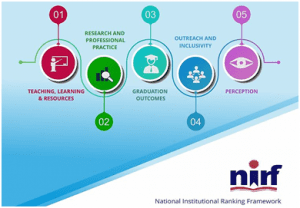
The ranking framework judges institutions under five broad generic groups of parameters of
- Teaching, Learning and Resources (TLR),
- Research and Professional Practice (RP),
- Graduation Outcomes (GO),
- Outreach and Inclusivity (OI),
- Perception (PR).
Ranks are assigned based on the total sum of marks assigned for each of these five broad groups of parameters.
ANALYZING IMPACTS OF RANKINGS ON LEARNING OUTCOMES
There is a new era in higher education, characterized by global competition, in which university ranking systems have assumed importance. Their emergence, often controversial and subject to considerable debate, has been met with a lot of scepticism, some enthusiasm and an institutional unease. Regardless, ranking systems are here to stay and it is important to assess their effect on the higher education sector and its stakeholders.
PRESENT STATUS
There are 864 Universities and 11669 Institutions in India but only 24 secured their places in the top 1000 list released by QS world university ranking.
- Even after 70 years of independence, India does not have even one world-class multidisciplinary research university. And just one university IISc Bangalore was ranked in the Top 500 of Global Rankings.
- If we talk about the top 100, 33 Institutes were from the USA, 15 from the UK, 7 from Germany, 6 from China and 5 from Japan.
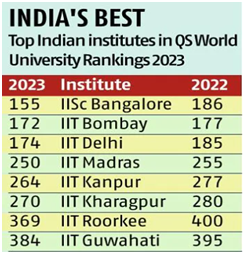
Reasons for the worst condition of Indian Institutions
- Even after liberalisation in the 1990s, there was no liberation of higher education from government control.
- People complained about the lack of autonomy and bureaucratic interference.
- There were some 17 bodies controlling each and every realm of higher education.
- The country was incapable of producing many things it desired. We could not produce the necessary defence equipments.
- Half of India’s students were pursuing courses in the liberal arts and sciences.
WHY DO WE NEED NIRF?
- The importance of a national ranking system is that it helps students choose the best university. A national ranking ensures that all higher educational institutes strive hard to improve their rankings.
- It also ensures that there is no complacency in the institutes and they work harder each year to provide quality education to students.
- Educationists have always voiced their concern about the absence of Indian universities, technology and management institutes from global rankings and the importance of these rankings.
- Thus, a national ranking framework ensures that universities keep working hard to ensure that they are providing scholastic education, at par with international standards.
NIRF: THE ASSESSMENT
Detailed assessment mechanism:
- Teaching and Learning Resources (TLR): This parameter deals with the basic activities related to any place of learning. It deals with the teaching and learning resources available to the institute and how they are being utilized.
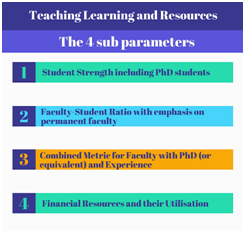
- Research and Professional Practice (RP): This parameter measures the quality of research being carried out, and the scholarships provided to students.

- Graduation Outcome (GO): This parameter judges the ultimate goal of students, graduation.
o Combined Metric for Placement, Higher Studies, and Entrepreneurship (GPHE): It is calculated based on the percentage of graduating students placed through campus placement over the past three years and the number of sustained start-ups or entrepreneurial adventures over the past five years.
o Metric for University Examinations (GUE): This is the number of students as a fraction of the approved intake who have passed the university exam within the stipulated time for the course they had enrolled in.
o Median Salary(GMS): It is the median salary of graduates who have passed from the institution.
o Metric for Number of PhD Students Graduated (GPHD): It is the average number of PhD students who have graduated over the past three years.
- Outreach and Inclusivity (OI): This is the parameter that deals with the representation of women, marginalized and minorities in the institution.
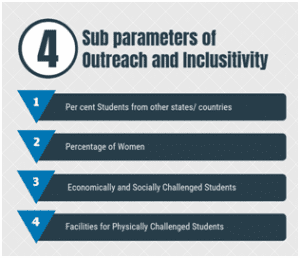
- Perception (PR): This parameter judges the overall perception of the institute by industry, peers and researchers. It is judged based on the following sub-parameters:
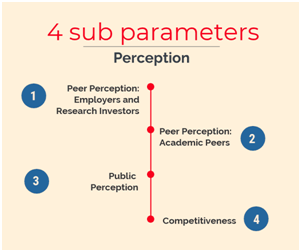
- A ranking is the best form of publicity and comparison. It shows that your institute is better than the rest, it shows that you provide quality education and ensures that the general public views your institute with trust.
- When students research colleges and universities, one parameter that they pay the most attention to is the ranking of the institute. Choosing the right educational institute is one of the most important and daunting tasks in a student’s life. A higher ranking ensures that students and their parents/guardians can place their trust in your institute.
- A better ranking gives you a better reputation by evaluating your institute better than the others and it is also proof that the general public likes and trusts the institute. A ranking is a testimonial that your institute has worked on every parameter and provided the best resources, infrastructure and facilities to the students.
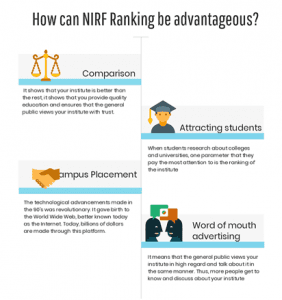
THE METHODOLOGY: PLACING VALUE ON INTEGRITY
- Institutions, universities and colleges are supposed to register and upload information according to the guidelines issued by the NIFR. They also have to upload the information submitted to NIRF on their own site for a period of three years. As a step towards encouraging transparency, the NIFR is empowered to do random and surprise audits on the data submitted by institutes. If the submitted data are inconsistent with the findings, the institute could be barred from participating in the ranking survey for the next two years.
- While the ranking depends heavily on self-declaration, asking institutes to publish data on their own site is a simple way of ensuring transparency and integrity of information.
NIRF RANKINGS: CRITICAL ANALYSIS
While it is laudable that the government is promoting a benchmark mostly based on objective indicators, it is a matter of concern that this does not serve the purpose of improving the standards of learning. The zeal to tick the right boxes can give results that do not conform to the ground reality, raising questions about the fairness and reliability of the assessment parameters.
IMPACT ON STUDENT ENROLMENT
- The impact of the NIRF rankings on improving students’ enrolment, is considered limited. That largely depends on the reputation, fee structure, infrastructural facilities, location and research output.
- According to the All-India Survey on Higher Education (AISHE), India’s GER was 27.4 per cent for 2017-18.
- This, in effect, means out of the total population in the age group of 18-23 in India, 27.4 per cent attend college and university.
SCOPE OF ATTRACTING FOREIGN STUDENTS
- India having a global ranking system of its own may be a project in the making, but eventually, quality and vastly improved standards are what will bring international students and faculty to the country, not hollow validation based on scores that project a distorted image.
NEED FOR RESEARCH DRIVEN INSTITUTES
- The industry connection will happen when research leads to better outcomes. That requires liberal funding for institutions that show promise, whether or not they figure high on rankings, putting an end to the meaningless exercise of churning out worthless, amateurish research papers just to get additional credit or help an individual acquire a degree.
- Although India has seen an exponential increase in the number of scientific publications over the last 10 years and is in the third position globally after China and the US, the conversion rates of these patents into working models are far less than desired.
- Although India is a hub of immense economic activity, its efforts to boost R&D and innovation are lagging. This can also be seen through the patenting activity in the country.
- India has been ranked 40th out of 53 countries on the Global Intellectual Property Index. Patenting activity is an indicator of innovation and India has seen an infinitesimally small rise over the years in the patent filing.
DEFINING PURPOSE
- The idea behind rankings should be to inform decisions, not drive admissions. Thus, even though the Gross Enrolment Ration (GER) could have spiked in recent times, the quality and quantity of worthy choices before students aren’t enough to be celebrated.
- As the NIRF evolves and involves more institutions, guidance from foreign and Indian experts should be of immense help, besides an honest review of its performance, the shortcomings and the additional parameters it needs to incorporate, like the financial health and size of the institution. The success of the endeavor lies in how beneficial it can be for students.
Tyranny of Geography
- There is discrimination present even in the top-rated universities and colleges in India. For example, certain courses in certain IITs are prefer it over the others. Also, the notion of explicit advantage of students belonging to tier one cities with regard to language and technological upgrade nations is visible clearly in such eminent institutes which somehow overlooks the overall quality of education in other institutes.
Global Comparisons
- Quacquarelli Symonds (QS) a leading global career and education network for ambitious professionals looking to further their personal and professional development.
- QS develops and successfully implements methods of comparative data collection and analysis used to highlight institutions’ strengths.
- The ‘QS World University Rankings’ is an annual publication of university rankings which comprises the global overall and subject rankings.
Six parameters and their weightage for the evaluation:
- Academic Reputation (40%)
- Employer Reputation (10%)
- Faculty/Student Ratio (20%)
- Citations per faculty (20%)
- International Faculty Ratio (5%)
- International Student Ratio (5%)
National Institutional Ranking Framework (NIRF): The ranking framework judges institutions under five broad generic groups of parameters of
- Teaching, Learning and Resources (TLR),
- Research and Professional Practice (RP),
- Graduation Outcomes (GO),
- Outreach and Inclusivity (OI),
- Perception (PR).
Ranks are assigned based on the total sum of marks assigned for each of these five broad groups of parameters.
Thus, clearly the NIRF is losing out on global standards like employment generation and foreign students.
THE WAY FORWARD:
- The NEP (National Education Policy) notes that quality education would enable us to occupy the “global stage” and cites.
- NEP also calls for attention to “local and global needs of the country”. It seeks the making of a truly global citizen through “Global Citizenship Education”. NEP calls for the use of global best practices for standard setting. India must thus, actualize best pedagogic practices to culminate patents into innovations.
- For multidisciplinary education and research universities (MERU), the NEP calls for the highest global standards. In its recognition of the need to give a global competitive edge to the students, the policy (which is not without its problems and critiques) offers us a way of thinking about Flagship Universities as well.
- To spur hundreds of universities and thousands of colleges to improve their level of excellence: give all higher education institutions complete autonomy. Let them all compete and get better. In tandem with increased transparency and accountability on outcomes, all the stakeholders’ students, industry, society and nation will benefit.
THE CONCLUSION: India has historically been the land of great universities and institutes which have given the world an unprecedented volume of wisdom and innovations. A similar perception needs to be created in present times. The advantage of improving our brand perception is that we get the added advantage of word-of-mouth advertising. It means that the general public views our institute in high regard and talks about it in the same manner. Thus, more people get to know and discuss about your institute, without any expenditure on advertising and marketing. It is also the most widespread and fast means of publicity. Hence, a good NIRF ranking has multiple advantages for any institute if projected and utilised in a goal driven manner. It is in our best interest that we strive for a better rank every time and establish your institute in the top echelons of higher education.
QUESTIONS TO PONDER
- “The idea behind rankings should be to inform decisions, not drive admissions.” Examine critically in the light of the recently released National Institutional Ranking Framework (NIRF).
- “There are many advantages of improving the brand perception of our institutes by means of better performance in competitive rankings.” Do you agree? Give valid arguments in support of your views.

